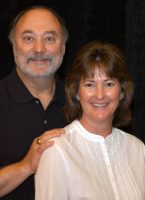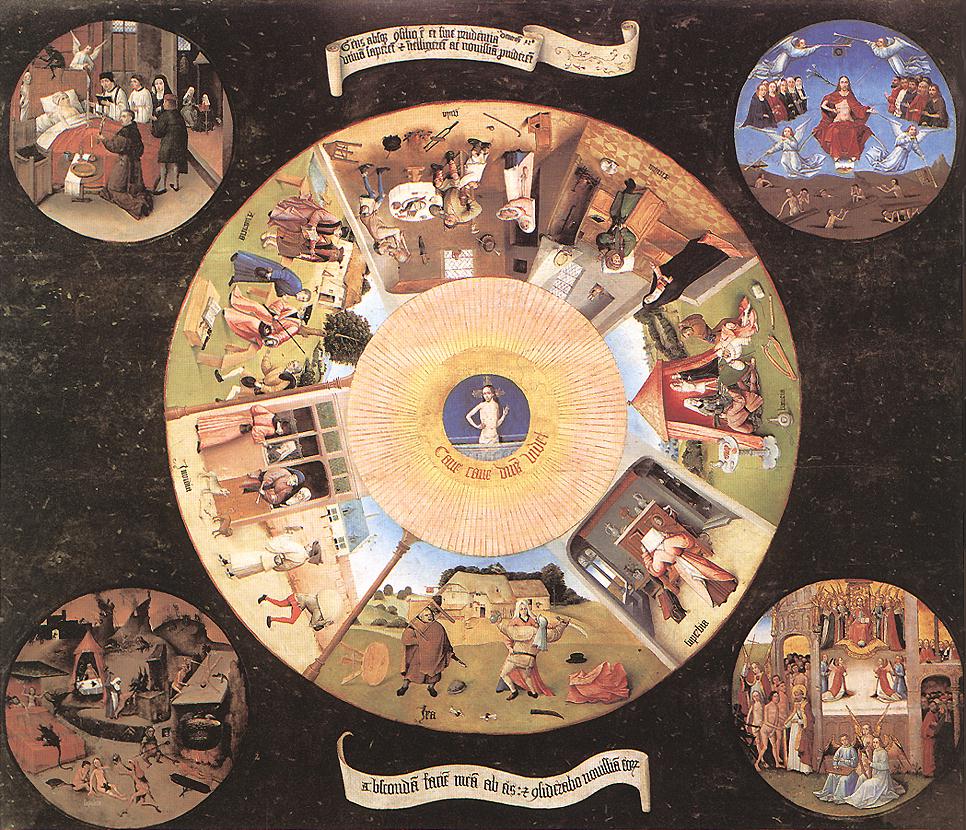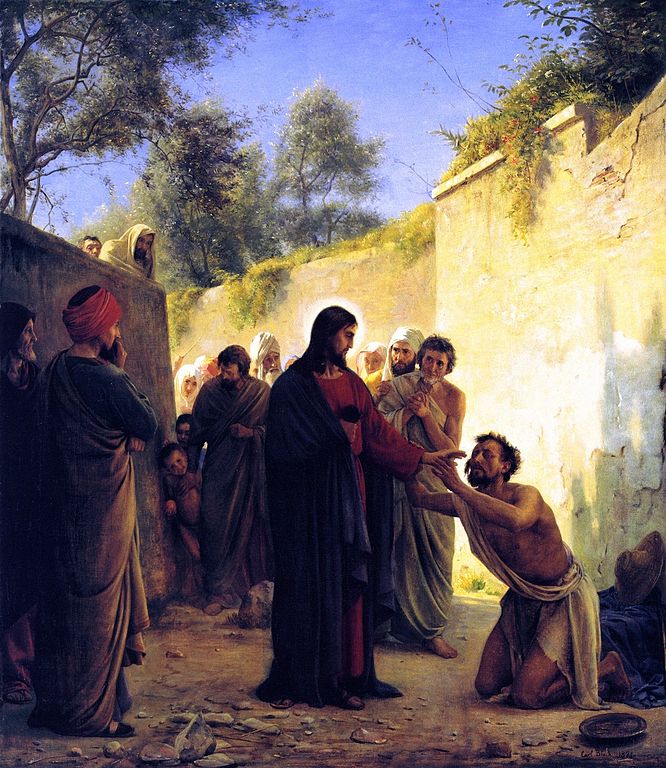Dear Brothers and Sisters,

In this season of Lent, it’s good to remember that sin is bigger and grace is deeper than many realize. We’ll take a look at both realities in this letter.
Sin is bigger
Most of us don’t like thinking or talking about sin, and we surely don’t like being on its receiving end. But what constitutes sin? Some people define it by making reference to the classic sin list, The Seven Deadly Sins [1]—it was the basis for the movie Seven (starring Morgan Freeman, Brad Pitt and Kevin Spacey) and the TV series Seven Deadly Sins. Most people agree that theft and murder are sins, but there is less agreement when it comes to other behaviors.

(public domain via Wikimedia Commons)
Some people compile their own sin lists, including such behaviors as watching movies, playing cards and dancing. Others include drinking alcoholic beverages, and some even see drinking Coca Cola and coffee as sins. In looking at these lists, it’s not hard to conclude that God must hate murder and lying more than he hates drinking a latte or a beer. That being the case, some people divide their sin lists into categories of presumed severity. Some label the most severe sins as “mortal sins,” and the less severe ones as “venial sins.” Scripture addresses sin, in some cases in the form of sin lists. Here are three such lists—one from the Old Testament and two from the New:
There are six things the Lord hates, seven that are detestable to him: haughty eyes, a lying tongue, hands that shed innocent blood, a heart that devises wicked schemes, feet that are quick to rush into evil, a false witness who pours out lies and a person who stirs up conflict in the community. (Proverbs 6:16-19)
The acts of the flesh are obvious: sexual immorality, impurity and debauchery; idolatry and witchcraft; hatred, discord, jealousy, fits of rage, selfish ambition, dissensions, factions and envy; drunkenness, orgies, and the like. I warn you, as I did before, that those who live like this will not inherit the kingdom of God. (Galatians 5:19-21)
But the cowardly, the unbelieving, the vile, the murderers, the sexually immoral, those who practice magic arts, the idolaters and all liars—they will be consigned to the fiery lake of burning sulfur. This is the second death. (Revelation 21:8)
All the behaviors in these sin lists are considered by Christians (and others) to be sin because, to one extent or another, they “miss the mark” of moral conduct. This idea of missing the mark is conveyed by some of the Hebrew and Greek words used in the Bible for sin. The idea is that to sin is to depart from (miss) the right path, which raises this question: How is the right path defined? Typically, people think of sin in terms of wrong actions and thoughts. That’s how I viewed sin for much of my life, defining it by the laws in Scripture. Others might define it by civil laws (here in the U.S., there are laws against nearly all the behaviors on the sin lists quoted above). But sin is far bigger than all the laws written in all the law books. I submit that there is a much higher, more all-encompassing standard we should use in defining sin.
Jesus: the standard

(public domain via Wikimedia Commons)
According to Karl Barth, the biblical concept of sin does not begin with the law—it begins with Jesus. He is the standard. Sin cannot be properly understood without reference to who Jesus is in relationship with God and humankind. As the Son of God and Son of Man, the God-man Jesus has fulfilled both relationships, perfectly living out the Great Commandments to love God and one’s neighbor as we are loved by God.
From this Christ-centered perspective, we understand sin to be about the breaking of good and right relationships—first with God, then with others. We sin when we violate the relationship we have with Jesus Christ and, through him, with the Father and the Spirit. And we sin when we damage the relationships with others that our triune God gives us. Therefore, more than sin being defined as breaking of the law, it is defined as anything opposing right relationships of faith, hope and love for God and for humanity, as lived out in Jesus’ life.
Jesus always acts in relationship according to who God is and who his neighbor is in relationship to God. His obedience is his conformity to the “demands” of right relationship with God and with others. He lives out of his worship relationship of complete faith (trust) in his Father, his word and his Holy Spirit. So it is in this way that Jesus glorifies God, showing him to be worthy of worship in all his relationships. Thus we understand that sin is much bigger than merely failing to follow the Ten Commandments or some other written code of law. Sin is failing to relate to God in the way God ordained—in and through Jesus Christ, the Son of God and Son of Man.
Make no mistake about it: sin is destructive. Notice what we say in our article, “What is Sin?”:
Sin is an internal power that affects everyone’s humanness—our very human nature. In effect, sin deceives us, enters us and dominates our existence. Sin enslaves us and takes us over as drugs enslave an addict. Sin is like a deadly virus that enters our human nature and takes control of us, using us for its own purposes. Sin reproduces itself within us and destroys our self. And the evil behaviors that result are the symptoms of our inner defectiveness.
While sin and human nature are not material substances or fixed structures we can identify, mark and box up, they are inseparable from what we are. Continuing from the article:
In fact, what happens is that our human nature itself is or becomes sin because sin corrupts the expression of our self, making human nature sinful. In short, sin is something that creates our sinful nature. It becomes our self or our ego. Paul, personifying the sinful nature or being as himself, said, “I am unspiritual, sold as a slave to sin” (Romans 7:14).
Grace is deeper
So that’s the nature of sin, which points to the bad news. But there is another, greater reality—it’s the very good news of God’s grace. As broken as we sinful humans may be, the God of love and grace does not throw us away. He does not give up on us, but remains faithful. Instead, he brings the dead to life through Jesus Christ. He is restoring the broken to a pristine new condition. He restores, redeems and reconciles us to himself through his Son, our Lord, Jesus Christ. We are no longer simply sinners, we are forgiven sinners who receive his grace and forgiveness daily.
God’s goal is for us to have eternal life in his presence—to be spiritually perfect as he is perfect. But to accomplish that purpose, God must clear away the imperfections (the sinfulness) that are part of our nature. We have to be remade, refashioned, regenerated or spiritually reborn (John 3:3-7; Titus 3:5-7)—and that is exactly what God accomplished for us in Jesus Christ. Note how Paul ended his thought in Romans 7: 24-25: “Who will rescue me from this body that is subject to death? Thanks be to God, who delivers me through Jesus Christ our Lord.” By the continuing ministry of the Holy Spirit we can share in Christ’s own justified and sanctified human nature, day by day as we look forward to one day sharing fully in his glorified humanity. That is how deep God’s grace reaches through Jesus and by the Holy Spirit.
During Lent [2] it’s good for us to remember the truth of the bad news of sin, and also the reality of the good news of grace: Jesus took our sinful nature upon himself, thus sanctifying our fallen human nature in himself, bringing it into a full and faithful obedience to God. His entire life, lived in our place and on our behalf, culminated in his words from the cross: “Father into your hands I commit my spirit!” (Luke 23:46). Jesus did all this so that we could be spiritually reborn, enabling us to follow the lead of the Holy Spirit in the way that transforms us in a Christomorphic direction.
Christomorphically yours,
Joseph Tkach
P.S. Christomorphic is my new favorite word. Just can’t get enough of it!
______________________
[1] The list known as The Seven Deadly Sins was compiled by Pope Gregory I in about A.D. 600. The seven sins are pride, greed, lust, envy, gluttony, anger and sloth. While Scripture identifies all seven as sin, it does not explicitly categorize them as being “deadly.”
[2] For a helpful article about Lent by Mark D. Roberts, click here.



“Sin cannot be properly understood without reference to who Jesus is in relationship with God and humankind. As the Son of God and Son of Man, the God-man Jesus has fulfilled both relationships, perfectly living out the Great Commandments to love God and one’s neighbor as we are loved by God.”
In Jesus the reflection of our shortcomings and imperfections become so very clear. Who can measure up to that perfect standard and revealing mirror? As human beings, we all woefully “miss the mark.” But, the Good News is that in and through Him, forgiveness, reconciliation, justification, sanctification, glorification and eternal salvation are all apprehended through grace.
My prayer:
May God help us walk uprightly in the example of Jesus at home, in our neighborhoods and in the marketplace, as faithful ambassadors and children representing and expressing the love of the Triune God and the true values of the Kingdom. May our actions speak just as loud as our words.
Some Protestants are (understandably) a bit leary about Lent. Their typical concerns are helpfully addressed in a Christianity Today article at https://tinyurl.com/lfxb69h.
Identifying the lack of a “right relationship” that one has with God and others as the point of origin for sin makes good theoretical sense but in practice is not so simple. Froese and Bader surveyed Americans and discovered that they believe in four distinct gods: an authoritative god, a benevolent god, a critical god and a distant god. Each conception of god would determine a different set of rules of relationship with that god. So a “right relationship” may be protean without resort to law or accepted principle. I would add to the findings of Froese and Bader, although I have no evidence yet, that most people feel that their personal conception of god is also everyone else’s. So when people speak about god they think they are speaking about the same concept but this is likely not so. In the course of a religious discussion, it would be interesting to pause and drill down and ask people who they think god is. The results may be surprising. What it means to me is that the grace of God must be very great to encompass and work with all of this diversity in understanding and viewpoint.
Thank you so much for this very inspiring and clarifying article. We pray for you often.
YB&SIC,
Eric and Edna